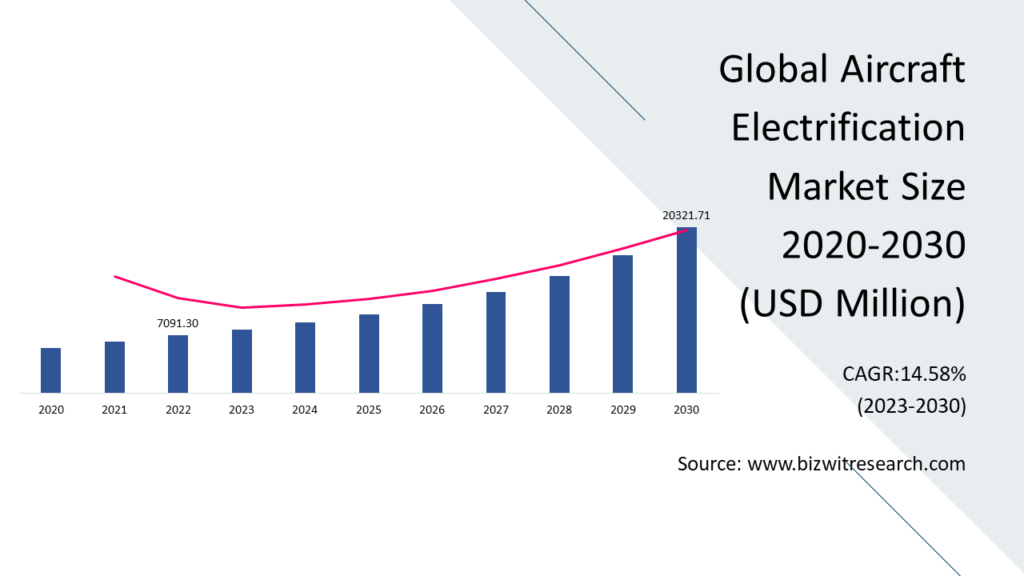Global Aircraft Electrification Market is valued approximately USD 7091.30 million in 2022 and is anticipated to grow with a healthy growth rate of more than 14.58% over the forecast period 2023-2030. Aircraft electrification is the process of replacing traditional mechanical, hydraulic, and pneumatic systems in aircraft with electrical systems. This involves using electric motors, batteries, and other power electronics to control various aircraft functions, including propulsion, environmental control, and flight control. Aircraft electrification has gained traction in recent years as a way to reduce the environmental impact of air travel.
Electric aircraft are much quieter and emit far fewer pollutants than traditional aircraft. In addition, they are more efficient, which means they use less fuel and can fly further on a single charge. The key factor driving the market growth is growing need for cleaner and quieter aircraft, advances in batteries, electric motors, and power electronics, increase in demand for unmanned aerial vehicles, and surging demand for electrical systems in aircraft that anticipated to create the lucrative demand for the market during forecast period.

For further analysis on the study, request a sample copy
Moreover, the rising demand for unmanned aerial vehicles (UAVs) is one of the factors driving the growth of the aircraft electrification market. UAVs require reliable and efficient power systems to operate, and electrification technologies are becoming increasingly popular to achieve these requirements. Electric propulsion systems are being used in UAVs to provide a more efficient and cleaner alternative to traditional combustion engines. These systems offer benefits such as reduced fuel consumption, lower emissions, and quieter operation, making them ideal for applications such as surveillance, reconnaissance, and cargo transport.
According to Statista, in 2018, the global unmanned aerial vehicles was valued USD 25.59 billion, and the number is anticipated to reach USD 70.28 billion by 2029. As a result, the rising UAVs market is anticipated to support the market growth during forecast period. Additionally, development of lithium-ion batteries, and emergence of advanced air mobility is anticipated to create the lucrative opportunity for the market during forecast period. However, the high limited range of electric aircraft stifles market growth throughout the forecast period of 2023-2030.
On the basis of component market is sub categorized into batteries, fuel cells, Electric Actuators, Generators, Motors, Power Electronics, Power Electronics and Distribution device. The dominance of the battery component in the global aircraft electrification market is underscored by its anticipated leadership role and a forecasted highest Compound Annual Growth Rate (CAGR) during the period from 2023 to 2030. This projection aligns with the dynamic landscape of technological advancements, where continuous breakthroughs in battery technology contribute to increased energy density, enhanced safety features, and reduced weight. As global trends toward electrification gain momentum across various industries, the aviation sector is poised to benefit, with batteries emerging as a key driver of this transformative shift.

In the global aircraft electrification market, the application segment is poised for a transformative shift, with power generation emerging as the leading force and exhibiting the highest projected Compound Annual Growth Rate (CAGR) from 2023 to 2030. This forecast is substantiated by several key factors driving the ascendancy of power generation within the aviation electrification landscape. The evolution of power generation technologies is playing a pivotal role, with advancements in electrical systems, generators, and associated components contributing to increased efficiency and reliability. Furthermore, the rising demand for electric and hybrid-electric propulsion systems in aircraft is bolstering the significance of power generation as a central component, driving innovation in the quest for enhanced performance and sustainability.

The global aircraft electrification market exhibits a distinctive regional pattern, with North America (NA) positioned as a frontrunner and the Asia-Pacific (APAC) region anticipated to experience the highest Compound Annual Growth Rate (CAGR). In North America, the presence of established aerospace industry giants, substantial research and development investments, and robust government support have collectively propelled the region to lead in the development and adoption of aircraft electrification technologies. The region’s commitment to sustainability, coupled with favorable policies promoting technological innovation, further strengthens its prominent role in the market.

On the other hand, the Asia-Pacific region, characterized by rapid economic growth and emerging markets such as China and India, is poised to witness substantial growth. The increasing demand for air travel, coupled with a growing middle class, creates a conducive environment for the adoption of more sustainable and efficient aviation solutions. Government initiatives aligning with environmental conservation and supportive policies are expected to drive the aircraft electrification market in APAC, contributing to the region’s projected highest CAGR. Additionally, the region’s reputation for swift technological adoption positions it as a key player in the ongoing evolution of the global aircraft electrification landscape.
Major market player included in this report are:
Ametek.Inc.
Astronics Corporation
BAE Systems
Collins Aerospace
Honeywell International Inc.
MagniX
Meggitt plc
Rolls-Royce plc
Safran S.A.
Thales Group
Recent Developments in the Market:
Ø In February 2022, Boeing was selected by GE Aviation to assist with flying tests of its hybrid-electric propulsion system using a modified Saab 340B aircraft and CT7-9B turboprop engines. Services for aircraft modification, system integration, and flight testing will be offered to GE Aviation by Boeing and its affiliate Aurora Flight Sciences.
Global Aircraft Electrification Market Report Scope:
ü Historical Data – 2020 – 2021
ü Base Year for Estimation – 2022
ü Forecast period – 2023-2030
ü Report Coverage – Revenue forecast, Company Ranking, Competitive Landscape, Growth factors, and Trends
ü Segments Covered – Component, Application, Technology, Region
ü Regional Scope – North America; Europe; Asia Pacific; Latin America; Middle East & Africa
ü Customization Scope – Free report customization (equivalent up to 8 analyst’s working hours) with purchase. Addition or alteration to country, regional & segment scope*
The objective of the study is to define market sizes of different segments & countries in recent years and to forecast the values to the coming years. The report is designed to incorporate both qualitative and quantitative aspects of the industry within countries involved in the study.
The report also caters detailed information about the crucial aspects such as driving factors & challenges which will define the future growth of the market. Additionally, it also incorporates potential opportunities in micro markets for stakeholders to invest along with the detailed analysis of competitive landscape and Component offerings of key players. The detailed segments and sub-segment of the market are explained below:
By Component:
Batteries
Fuel Cells
Electric Actuators
Generators
Motors
Power Electronics
Distribution Devices
Others
By Application:
Power Generation
Power Distribution
Power Conversion
Energy Storage
By Technology:
More Electric
Hybrid Electric
Fully Electric
By Region:
North America
U.S.
Canada
Europe
UK
Germany
France
Spain
Italy
ROE
Asia Pacific
China
India
Japan
Australia
South Korea
RoAPAC
Latin America
Brazil
Mexico
Middle East & Africa
Saudi Arabia
South Africa
Rest of Middle East & Africa







